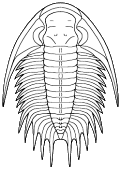TO THE ORDER PROETIDA
last revised 15 July 2007 by S. M. Gon III
Superfamily Proetoidea

Compare the pictorial approach above with the descriptive narrative below:

Compare the pictorial approach above with the descriptive narrative below:
| Superfamily Proetoidea
Cephalon: opisthoparian sutures, glabella tapering or inverse pyriform, mostly suboval, with 3-4 pairs of lateral furrows, sometimes indistinct (Proetidae), or glabella long, expanding forward to anterior border furrow or beyond, with lateral preoccipital lobes present (Phillipsiidae); eyes, when present, typically holochroal, convex; fixigenae narrow, librigenae broad, except in blind species; hypostoma typically natant, but secondarily conterminent in advanced Proetidae; genal angle spined or blunt rounded. Thorax: 8-10 segments, typically 10 in Protetidae, 9 in Phillipsiidae, pleurae with furrows, tips blunt or spined. Pygidium: typically semicircular, with few segments, but some large, long, parabolic, with up to 33 axial segments; margin typically smooth, but some with terminal axial spine or pleural spines. Families: Phillipsiidae, Proetidae Representative Genera: Ameura, Basidechenella, Bollandia, Cornuproetus, Cummingella, Cyphoproetus, Dechenella, Decoroproetus, Ditomopyge, Eremiproetus, Griffithides, Humilogriffithides, Neogriffithides, Paraphillipsia, Phillipsia, Prantlia, Proetidella, Proetus, Pseudophillipsia, Warburgella, Weberides |
Here are some representative Proetoidea
| Phillipsia | Cornuproetus | Phaetonellus | Cyphoproetus |
 |
 |
 |
 |
PROETIDA includes three Superfamilies:
(click on the images to view the pictorial guides)
| Proetoidea | Aulacopleuroidea | Bathyuroidea |

Walking Trilobite animation ©2000
by S. M. Gon III
All line drawings this page ©1999 - 2007 by
S.
M. Gon III